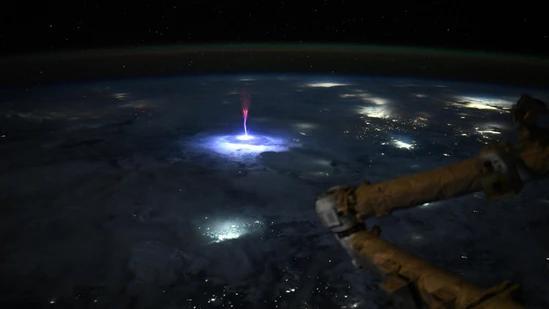
NASA Astronaut Captures Rare ‘Sprite’ Lightning Over US & Mexico
In a remarkable feat, NASA astronaut Nichole Ayers has captured a rare and breathtaking image of a “sprite” lightning phenomenon while orbiting above the United States and Mexico from the International Space Station (ISS). The stunning photo has left scientists and enthusiasts alike in awe, providing a unique opportunity to study this elusive atmospheric phenomenon.
Ayers, a seasoned astronaut with NASA, shared the picture on social media, showcasing the vibrant display of light above the thunderstorms. The sprite, a type of Transient Luminous Event (TLE), is a brief burst of light that occurs above thunderstorms, typically at altitudes of around 50 to 100 kilometers (31 to 62 miles). This phenomenon is relatively rare and often difficult to capture, making Ayers’ image a valuable addition to the scientific community’s understanding of TLEs.
According to Ayers, sprites are often accompanied by intense thunderstorms, which can produce electrical discharges that interact with the upper atmosphere. These interactions can create the spectacular displays of light that Ayers captured from the ISS. The astronaut emphasized the importance of these images in helping scientists better comprehend the relationship between TLEs and thunderstorms, stating, “Scientists can use these types of photos to better understand the dynamics of TLEs and their connection to thunderstorms.”
The image captured by Ayers is a testament to the extraordinary capabilities of the ISS, which has been orbiting the Earth since 1998. The space station’s unique vantage point allows astronauts to capture stunning views of our planet, including rare atmospheric phenomena like sprites. This capability has contributed significantly to our understanding of Earth’s atmosphere and the complex interactions that occur within it.
Sprites are not the only type of TLE. Others include “blue jets” and “gigantic jets,” which are similar in appearance but differ in their altitude and duration. TLEs are thought to occur when electrical discharges within thunderstorms interact with the upper atmosphere, creating the brief flashes of light that we see. These events are often associated with severe thunderstorms, which can produce powerful electrical discharges that can reach the upper atmosphere.
The study of TLEs is crucial for understanding the intricacies of thunderstorms and the complex interactions that occur within them. By analyzing images like Ayers’, scientists can gain valuable insights into the dynamics of TLEs and their relationship to thunderstorms. This knowledge can ultimately help improve weather forecasting and potentially even mitigate the impact of severe thunderstorms on communities.
Ayers’ remarkable image has sparked widespread interest in the scientific community, with many experts hailing it as a groundbreaking capture. The astronaut’s dedication to sharing her findings with the public has also inspired a new generation of scientists and enthusiasts to explore the wonders of our atmosphere.
In conclusion, NASA astronaut Nichole Ayers’ capture of a rare “sprite” lightning phenomenon over the US and Mexico is a testament to the extraordinary capabilities of the ISS and the dedication of NASA scientists. This stunning image provides a unique opportunity for scientists to study the relationship between TLEs and thunderstorms, ultimately contributing to our understanding of the intricacies of our planet’s atmosphere.






